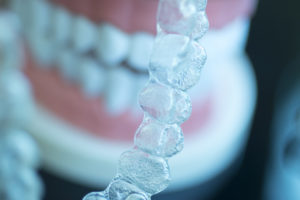Invisalign could be the right solution for you.
While most people initially turn to this modern orthodontic solution for aesthetic reasons, Invisalign removable braces were developed to treat numerous dental issues.
Correct tooth placement can lead to so much more than a brighter smile. It can help to reduce gum disease, create an accurate bite (and less chance of broken teeth), eliminate jaw and neck pain, and promote overall easier-to-maintain oral health.
As an Invisalign® Gold Tier practitioner, Sunnyside’s Dr. Koning is among the most experienced dental professionals in Kelowna. Her comprehensive, continually updated knowledge of the applications of this clear aligner system allows her to advise patients on the best course of action to address their varied dental health concerns.
Non-invasive Invisalign can help with the following mild-to-moderate dental and orthodontic problems in most patients.*
Overbite and Overjet
Most people use the term overbite to describe both of these issues, but they’re actually different, common problems.
An overbite –or a deep bite– is a malocclusion wherein the top teeth cover up too much of the bottom teeth, vertically. Some overbite is common and non-problematic, but in patients with more than 25% of their bottom teeth hidden, there is an increased risk of excessive wear and potential breakage of the front top and bottom teeth.
An overjet occurs when the top teeth project far (more than 2mm) beyond the lower jawline. This is often referred to as having buck teeth. It can lead to jaw pain, tooth wear, and even breathing and speech problems.
In many patients, Invisalign can be used to adjust the position of the upper and lower jaws to correct both overbite and overjet without significantly changing the patient’s facial features. Sometimes, small nodes attached directly to the tooth (called Smart Force Attachments) are used in combination with rubber bands and the program’s Mandibular Advancement wings to adjust jaw alignment.
Underbite
The term underbite describes the misalignment of the jaws that results in the lower jaw protruding in front of the upper teeth. While this is a benefit to some members of the animal kingdom (like piranhas and bulldogs), it’s generally problematic for most humans. It can affect biting and chewing, speech patterns, and (like most malocclusions) excessive tooth wear and mandibular joint pain.
Correcting an underbite can be important for general oral health, to help preserve tooth enamel and to prevent musculoskeletal irritation. Invisalign is an effective treatment for some underbites, although severe cases may require surgery.
Crossbite
Though not as common an ailment, we do see patients in our Sunnyside office who suffer from crossbite –where a portion of the jaws is horizontally misaligned affecting some of the teeth, particularly the insides of the lower teeth.
A crossbite can make it difficult to smile and make you more susceptible to tooth chipping. In some cases it can affect your jaw joints and facial muscles, leading to fatigue and pain, or it can make you vulnerable to gum issues and jawbone loss.
Invisalign can fix some crossbites with gradual and precise jaw realignment. This treatment usually requires the abovementioned Smart Force attachments, as significant jaw movement is needed. If we cannot address your crossbite issue in-office, our dentists will refer patients as needed to a maxillofacial surgeon or orthodontic specialist.
Open Bite
An open bite is classified as a malocclusion where the top and bottom teeth don’t touch when the mouth is fully closed. Usually, this occurs only in a portion of the mouth (like the front teeth), and can be caused by genetics or by a continued interference during the development stage (like sucking a thumb).
An open bite can affect speech development and can make it difficult to bite properly. It can also increase the risk of TMD.
At Sunnyside, we have successfully treated cases of open bite using Invisalign. Using precise adjustments and continuous pressure, the trays gradually move the affected teeth into the proper position. An accurate bite and proper alignment of the teeth lead to better overall oral health. As with all malocclusions, some cases may be better addressed with surgical treatment.
Tooth Gaps
Many people have space between two (or more) teeth. Most often this is between the two front, upper teeth, but it can happen anywhere in the mouth. Excessive gum tissue, tooth loss, or undersized teeth can cause this issue. While a gap between the teeth, or diastema, can look charming, it can sometimes bring with it more than just personality.
Gaps between teeth offer food and bacteria wonderful places to hide. This can lead to cavities and gum irritation, or even severe gum disease, which has been linked to heart disease and other serious medical problems. Gaps can also leave teeth vulnerable to damage.
Invisalign is a great solution for gap teeth with up to 6mm of separation. Over the course of treatment, the removable tray system can gently bring the neighbouring teeth together into a strong arch. With the help of Smart Force Attachments, Invisalign can address more complex concerns, such as tooth rotation, to help eliminate the spaces. Depending on the underlying issue, further cosmetic or restorative procedures might be necessary to create the ideal, healthy smile.
Tooth Crowding
While some people may have too much room in their mouths, others suffer from too little space. Tooth crowding is a very common problem, and one that can get worse as we age. When there is not enough room in the jawline, teeth can get pushed together unevenly, forced to turn, shift inward, or protrude outward.
Aesthetics aside, crowded teeth can be difficult to maintain. Flossing and brushing may not reach all of the tooth surfaces, and bacteria can stay trapped in difficult corners. Gum disease and tooth decay are common problems in crowded mouths.
Invisalign removable braces are an excellent solution for most patients with crowded teeth. The aligners can straighten teeth and shift them to make more room along the jawline, creating a healthier bite, usually in less time than traditional braces would take. As with all Invisalign procedures, further treatment may be required in some cases.
Invisalign continues to lead the orthodontic industry with its cutting-edge technology, safe and unobtrusive materials, and exceptional results. More than 6 million patients worldwide have benefitted from this advanced system.
Come in to speak with our Sunnyside team today, to learn if this is the treatment you’ve been waiting for. Contact us to book your free consultation.
*Please note: while Invisalign clear aligners can be an effective treatment for many common malocclusions, some patients may be referred to a specialist for more aggressive intervention. Your Sunnyside dental professionals will provide you with a personalized assessment.

